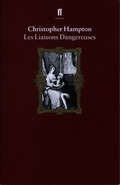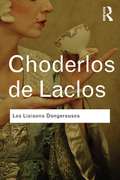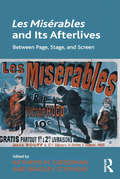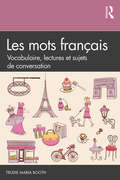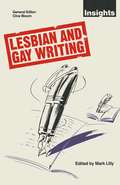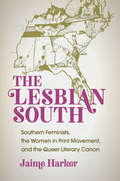- Table View
- List View
Les Liaisons Dangereuses
by Christopher HamptonThe scandalous reputation of Laclos's novel, first published in 1782, is based on its chilling portrayal of the mannered decadence and sexual cynicism of the French aristocracy in the last years of the ancien regime. Christopher Hampton has made a masterful adaptation for the stage of the conspiracy to corrupt a young girl barely out of her convent.Les liaisons dangereuses was premiered by Royal Shakespeare Company at The Other Place, Stratford-upon-Avon, on 24 September 1985, and won Christopher Hampton the Evening Standard Award for Best Play and the Laurence Olivier Award for Best New Play in 1986.
Les Liaisons Dangereuses
by Choderlos De LaclosOne of the most `modern' of eighteenth-century novels, Les Liasons Dangereuses is the brilliantly observed and vividly rendered story of two libertines and the innocent characters they plot to destroy.
Les Liaisons Dangereuses
by Pierre Choderlos de Laclos‘I resolved to write a book which would create some stir in the world and continue to do after I had gone from it.’ - Choderlos de Laclos A great sensation at the time of first publication, Les Liaisons Dangereuses reads as much the most 'modern' of eighteenth-century novels. Viewed by some critics as a morality tale and others as a subtle inquiry into libertinism, it brilliantly depicts the foibles of the French aristocracy on the eve of the French Revolution. Renowned for its exploration of lust, revenge and human malice, and still carrying a tremendous power to shock, its adaptations for screen and stage have made its central characters notorious for their sophisticated and ultimately tragic games of seduction and manipulation.
Les Liaisons Dangereuses
by Pierre Choderlos de Laclos‘I resolved to write a book which would create some stir in the world and continue to do after I had gone from it.’ - Choderlos de Laclos A great sensation at the time of first publication, Les Liaisons Dangereuses reads as much the most 'modern' of eighteenth-century novels. Viewed by some critics as a morality tale and others as a subtle inquiry into libertinism, it brilliantly depicts the foibles of the French aristocracy on the eve of the French Revolution. Renowned for its exploration of lust, revenge and human malice, and still carrying a tremendous power to shock, its adaptations for screen and stage have made its central characters notorious for their sophisticated and ultimately tragic games of seduction and manipulation.
Les Misérables and Its Afterlives: Between Page, Stage, and Screen
by Kathryn M. Grossman Bradley StephensExploring the enduring popularity of Victor Hugo’s Les Misérables, this collection offers analysis of both the novel itself and its adaptations. In spite of a mixed response from critics, Les Misérables instantly became a global bestseller. Since its successful publication over 150 years ago, it has traveled across different countries, cultures, and media, giving rise to more than 60 international film and television variations, numerous radio dramatizations, animated versions, comics, and stage plays. Most famously, it has inspired the world's longest running musical, which itself has generated a wealth of fan-made and online content. Whatever its form, Hugo’s tale of social injustice and personal redemption continues to permeate the popular imagination. This volume draws together essays from across a variety of fields, combining readings of Les Misérables with reflections on some of its multimedia afterlives, including musical theater and film from the silent period to today's digital platforms. The contributors offer new insights into the development and reception of Hugo's celebrated classic, deepening our understanding of the novel as a work that unites social commentary with artistic vision and raising important questions about the cultural practice of adaptation.
Les Misérables and Its Afterlives: Between Page, Stage, and Screen
by Kathryn M. Grossman Bradley StephensExploring the enduring popularity of Victor Hugo’s Les Misérables, this collection offers analysis of both the novel itself and its adaptations. In spite of a mixed response from critics, Les Misérables instantly became a global bestseller. Since its successful publication over 150 years ago, it has traveled across different countries, cultures, and media, giving rise to more than 60 international film and television variations, numerous radio dramatizations, animated versions, comics, and stage plays. Most famously, it has inspired the world's longest running musical, which itself has generated a wealth of fan-made and online content. Whatever its form, Hugo’s tale of social injustice and personal redemption continues to permeate the popular imagination. This volume draws together essays from across a variety of fields, combining readings of Les Misérables with reflections on some of its multimedia afterlives, including musical theater and film from the silent period to today's digital platforms. The contributors offer new insights into the development and reception of Hugo's celebrated classic, deepening our understanding of the novel as a work that unites social commentary with artistic vision and raising important questions about the cultural practice of adaptation.
Les mots français: Vocabulaire, lectures et sujets de conversation
by Trudie Maria BoothLes mots français: Vocabulaire, lectures et sujets de conversation presents a clear, thorough and systematic overview of modern French vocabulary on a variety of subjects. Written in the target language, each of the 32 chapters is divided into the following sections, with translations into English to facilitate the learning process: • basic vocabulary (vocabulaire de base) • additional vocabulary (vocabulaire supplémentaire) • related vocabulary (vocabulaire apparenté) • idiomatic expressions, sayings and proverbs (proverbes et expressions) • cultural readings (lectures). The book includes a range of communicative exercises and sample sentences, while an answer key and flashcards are available online. This is essential reading for learners at level A2–C2 of the Common European Framework for Languages, and Intermediate Mid–Advanced on the ACTFL proficiency scales.
Les mots français: Vocabulaire, lectures et sujets de conversation
by Trudie Maria BoothLes mots français: Vocabulaire, lectures et sujets de conversation presents a clear, thorough and systematic overview of modern French vocabulary on a variety of subjects. Written in the target language, each of the 32 chapters is divided into the following sections, with translations into English to facilitate the learning process: • basic vocabulary (vocabulaire de base) • additional vocabulary (vocabulaire supplémentaire) • related vocabulary (vocabulaire apparenté) • idiomatic expressions, sayings and proverbs (proverbes et expressions) • cultural readings (lectures). The book includes a range of communicative exercises and sample sentences, while an answer key and flashcards are available online. This is essential reading for learners at level A2–C2 of the Common European Framework for Languages, and Intermediate Mid–Advanced on the ACTFL proficiency scales.
Lesbian and Gay Writing (Insights)
by Mark LillyPart of a series which looks at contemporary criticism on neglected literary and cultural areas, this book examines the conventional academic view of lesbian/gay writing and has essays on lesbian writers as well as a section on gay men's writing. All the critical essays are by lesbians or gay men.
Lesbian Discourses: Images of a Community (Routledge Studies in Linguistics)
by Veronika KollerLesbian Discourses is the first book-length treatment of lesbian text and discourse. It looks at what changing images of community American and British lesbian authors have communicated since 1970, how this change can be traced in texts such as pamphlets, magazines and blogs, and why this change has taken place. At the heart of the book is a detailed linguistic analysis, which is embedded in a discussion of the relevant socio-political contexts and discourse practices, and supplemented by interview data. The book can more generally be read as an example of how to do textual analysis in social research, in particular how to engage in the discourse-historical and socio-cognitive study of collective identity. Despite its text-centered approach, the book avoids being overly technical and will therefore be of interest not only to postgraduate students and researchers in linguistics but also to those in anthropology, history and sociology, especially women’s/gender studies.
Lesbian Discourses: Images of a Community (Routledge Studies in Linguistics)
by Veronika KollerLesbian Discourses is the first book-length treatment of lesbian text and discourse. It looks at what changing images of community American and British lesbian authors have communicated since 1970, how this change can be traced in texts such as pamphlets, magazines and blogs, and why this change has taken place. At the heart of the book is a detailed linguistic analysis, which is embedded in a discussion of the relevant socio-political contexts and discourse practices, and supplemented by interview data. The book can more generally be read as an example of how to do textual analysis in social research, in particular how to engage in the discourse-historical and socio-cognitive study of collective identity. Despite its text-centered approach, the book avoids being overly technical and will therefore be of interest not only to postgraduate students and researchers in linguistics but also to those in anthropology, history and sociology, especially women’s/gender studies.
The Lesbian Lyre: Reclaiming Sappho for the 21st Century
by Jeffrey M. DubanHailed by Plato as the “Tenth Muse” of ancient Greek poetry, Sappho is inarguably antiquity’s greatest lyric poet. Born over 2,600 years ago on the Greek island of Lesbos, and writing amorously of women and men alike, she is the namesake lesbian. What’s left of her writing, and what we know of her, is fragmentary. Shrouded in mystery, she is nonetheless repeatedly translated and discussed – no, appropriated – by all. Sappho has most recently undergone a variety of treatments by agenda-driven scholars and so-called poet-translators with little or no knowledge of Greek. Classicist-translator Jeffrey Duban debunks the postmodernist scholarship by which Sappho is interpreted today and offers translations reflecting the charm and elegant simplicity of the originals.Duban provides a reader-friendly overview of Sappho’s times and themes, exploring her eroticism and Greek homosexuality overall. He introduces us to Sappho’s highly cultured island home, to its lyre-accompanied musical legends, and to the fabled beauty of Lesbian women. Not least, he emphasizes the proximity of Lesbos to Troy, making the translation and enjoyment of Homer’s Iliad and Odyssey a further focus.More than anything else, argues Duban, it is free verse and its rampant legacy – and no two persons more than Walt Whitman and Ezra Pound – that bear responsibility for the ruin of today’s classics in translation, to say nothing of poetry in the twentieth century. Beyond matters of reflection for classicists, Duban provides a far-ranging beginner’s guide to classical literature, with forays into Spenser and Milton, and into the colonial impulse of Virgil, Spenser, and the West at large.
The Lesbian Muse and Poetic Identity, 1889–1930 (Gender and Genre)
by Sarah ParkerThroughout history the poetic muse has tended to be (a passive) female and the poet male. This dynamic caused problems for late Victorian and twentieth-century women poets; how could the muse be reclaimed and moved on from the passive role of old? Parker looks at fin-de-siècle and modernist lyric poets to investigate how they overcame these challenges and identifies three key strategies: the reconfiguring of the muse as a contemporary instead of a historical/mythological figure; the muse as a male figure; and an interchangeable poet/muse relationship, granting agency to both.
The Lesbian Muse and Poetic Identity, 1889–1930 (Gender and Genre #12)
by Sarah ParkerThroughout history the poetic muse has tended to be (a passive) female and the poet male. This dynamic caused problems for late Victorian and twentieth-century women poets; how could the muse be reclaimed and moved on from the passive role of old? Parker looks at fin-de-siècle and modernist lyric poets to investigate how they overcame these challenges and identifies three key strategies: the reconfiguring of the muse as a contemporary instead of a historical/mythological figure; the muse as a male figure; and an interchangeable poet/muse relationship, granting agency to both.
The Lesbian Premodern (The New Middle Ages)
by Noreen Giffney Michelle M. Sauer Diane WattKey scholars in the field of lesbian and sexuality studies take part in an innovative conversation that offers a radical new methodology for writing lesbian history and geography, drawing new conclusions on the important and often overlooked work being done on female same-sex desire and identity in relation to premodern cultures.
The Lesbian South: Southern Feminists, the Women in Print Movement, and the Queer Literary Canon
by Jaime HarkerIn this book, Jaime Harker uncovers a largely forgotten literary renaissance in southern letters. Anchored by a constellation of southern women, the Women in Print movement grew from the queer union of women's liberation, civil rights activism, gay liberation, and print culture. Broadly influential from the 1970s through the 1990s, the Women in Print movement created a network of writers, publishers, bookstores, and readers that fostered a remarkable array of literature. With the freedom that the Women in Print movement inspired, southern lesbian feminists remade southernness as a site of intersectional radicalism, transgressive sexuality, and liberatory space. Including in her study well-known authors—like Dorothy Allison and Alice Walker—as well as overlooked writers, publishers, and editors, Harker reconfigures the southern literary canon and the feminist canon, challenging histories of feminism and queer studies to include the south in a formative role.
Lesbianism in Swedish Literature: An Ambiguous Affair
by J. BjörklundHere, Björklund shows that Swedish literary discourses on lesbianism provocatively contrast with a widely accepted view that attitudes toward homosexuality have gradually become more tolerant. The lasting power of negative discourses upends the assumption that Sweden's progressive laws reflect progressive attitudes toward homosexuality.
Lesbians in Television and Text after the Millennium
by R. BeirneTaking up such issues as mainstreaming, the male gaze, and female masculinity, this book puts forward provocative readings of little explored texts and offers new insights into the contemporary representation of lesbians.
Lese-Rechtschreib-Störung und Bildungsbiografie: Die Bedeutung des schulischen Schriftspracherwerbs für die Identitätsentwicklung (Rekonstruktive Bildungsforschung #17)
by Susanne WilckensSusanne Wilckens untersucht den Umgang von Schule mit der Lese-Rechtschreib-Störung. Der fachwissenschaftliche Zugriff auf Modelle des Schriftspracherwerbs, dessen kulturtheoretische Einbettung sowie die komplementäre erziehungswissenschaftliche Perspektive auf die Schule und ihre gesellschaftlichen Rahmenbedingungen ermöglichen ihr einen differenzierten Blick auf die pädagogische Praxis. Auf der Grundlage eines rekonstruktiven Forschungsdesigns zeigt die Autorin am Beispiel der Lese-Rechtsschreib-Störung, dass Inklusion in der Praxis hinter fachlichen und professionstheoretischen Ansprüchen zurückbleibt. Zur Folge hat dies für die Bildungsbiografien betroffener Schülerinnen und Schüler, dass sie sich aus der Gemeinschaft der cultural peers ausgeschlossen fühlen.
Lesebarrieren in einem inklusiven Mathematikunterricht überwinden: Ergebnisse einer qualitativen und einer quantitativen Studie (Landauer Beiträge zur mathematikdidaktischen Forschung)
by Anna NollVor dem Hintergrund der großen Heterogenität von Schülerinnen und Schülern in der Sekundarstufe stellen sich vielfältige Fragen zur Gestaltung von Fachunterricht. Im Mathematikunterricht bilden Aufgabentexte einen häufigen Leseanlass. Wird eine Aufgabenstellung nicht verstanden, kann die Bearbeitung der Aufgabe und damit das Lernen an der Aufgabe bereits an dieser Stelle im Lernprozess scheitern. Dadurch können schwache Leserinnen und Leser im Bildungsprozess benachteiligt werden. Diese Problematik erhält durch den Anspruch einer inklusiven Bildung besondere Relevanz. Die Autorin liefert Erkenntnisse darüber, wie Lesebarrieren reduziert werden können, sodass möglichst alle Lernenden unabhängig von ihrer Lesekompetenz auf den mathematischen Inhalt von Aufgaben zugreifen können. Dazu werden verschiedene visuelle (Fotos, Piktogramme) und sprachliche (Leichte Sprache) Unterstützungsmaßnahmen im Rahmen einer qualitativen und einer quantitativen Studie untersucht.
Leseerzählungen: Alternativen zum hermeneutischen Verfahren. M & P Schriftenreihe
by Robert StockhammerLesen als Deutung: Moderne Romane Großbritanniens und ihre Lektüre im dritten Lebensalter (Edition Kulturwissenschaft #187)
by Hans-Christoph RammDas Erzählen von Geschichten ist eine Grunderfahrung zwischenmenschlicher Interaktion. Im Gegensatz zu Alltags- und Lebensgeschichten, in denen subjektive Wahrheit und Realitätserfahrungen dargestellt werden, zeichnen sich literarische Werke durch ihren Möglichkeitshorizont aus. Auf der Grundlage einer psychoanalytisch erweiterten kultursemiotischen Theorie, in der das Unbewusste nicht als Widervernünftiges, sondern als diagnostisch generatives Kulturmodell verstanden wird, erschließt Hans-Christoph Ramm ausgewählte moderne Romane Großbritanniens als hermeneutische Deutungsräume. Im dialogischen Bezug zwischen Rezipient_innen des dritten Lebensalters und Romanen von Thomas Hardy, D.H. Lawrence und Virginia Woolf zeigt er, wie Fähigkeiten zur Kreativität im Alter auf den Rätselcharakter der Werke treffen.
Lesen im Zeitalter der Künstlichen Intelligenz: Über den Wandel einer Kulturtechnik (Wie wir lesen - Zur Geschichte, Praxis und Zukunft einer Kulturtechnik #6)
by Florian RötzerWir stehen vor einem kulturellen Umbruch der Kulturtechnik Lesen, die mit der Erfindung der Schrift begann und über den Buchdruck in die Digitalisierung mündete: Mit den »Sprachmodellen« der lernenden Künstlichen Intelligenz treten neben die Menschen plötzlich unmenschliche maschinelle Leser, die alle Texte rezipieren und zu neuen Texten verarbeiten können. Sie lesen Texte als binär codierte Informationsströme und verstehen das Geschriebene nicht, sondern lernen eine wahrscheinliche Wortkombinatorik - aus der trotzdem Unerwartetes geschehen kann. Florian Rötzer wagt eine Nachlese und beantwortet die Frage, ob KI die menschlichen Leser*innen verdrängt oder ob die Kulturtechnik des Lesens durch die neuen Einflüsse nur revolutioniert wird.
Lesen / Sehen: Literatur als wahrnehmbare Kommunikation (Literatur - Medien - Ästhetik #5)
by Charlotte Coch Torsten Hahn Nicolas PethesLiteratur ist nicht einfach eine Sammlung von Texten - sie ist ein materielles, haptisches und nicht zuletzt visuelles Erlebnis. Der Blick der Lesenden wird gleichermaßen fasziniert und irritiert durch das Aufscheinen des Wortes - nicht als auflösbares Zeichen, sondern als gedrucktes Artefakt. Theoretisch ist dies immer wieder ins Feld geführt worden - etwa in Luhmanns Funktionsbestimmung der Literatur -, im wissenschaftlichen Umgang mit literarischen Texten dominiert jedoch das Lesen. Die Beiträge des Bandes widmen sich einer theoretischen, methodischen und praktischen Symmetrisierung von Lesen und Sehen für die Literatur des 18. bis 21. Jahrhunderts.
Lesen und Gefangen-Sein: Gefängnisbibliotheken in der Schweiz
by Thomas SutterIn der ersten umfassenden Untersuchung zum Bücherverleih und zu den Bibliotheken in Schweizer Gefängnissen und Justizvollzugseinrichtungen zeigt Thomas Sutter auf, wie Organisation, Strukturen und personelle Faktoren die Gefängnisbibliotheksarbeit beeinflussen und welche Lektüremodalitäten in Gefangenschaft an Bedeutung gewinnen. Zusätzlich geht der Autor in einer komparativen Analyse von fünf ausgewählten Gefängnisromanen der literarischen Darstellung des Bücherlesens, der Bibliotheken und der Leserfiguren nach. In einem übergreifenden Fazit werden schließlich die Bedeutung des Lesens im Gefängnis(roman) diskutiert und Handlungsempfehlungen für die Gefängnisbibliotheksarbeit formuliert.
